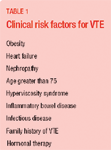Editorial: Preventing VTE: Part 2, gynecologic surgery
The pathogenic triad of vascular stasis, hypercoagulability, and vascular injury remains the prime initiator of thrombosis, and gynecologic surgery is associated with all three.

It's not surprising, then, that venous thromboembolism (VTE) is quite common after major gynecologic surgery. Geerts and associates' review of 19 studies employing very sensitive tests for deep venous thrombosis (DVT) found that 16% of 2,268 patients who underwent gynecologic surgerywithout prophylaxis developed DVT, while the published prevalence of fatal acute pulmonary embolism (PE) after such procedures was 0.4%.4 Not surprisingly, thromboprophylaxis is associated with a 75% reduction in this risk. Yet two questions remain to be answered: What is the optimal approach to thromboprophylaxis in gynecologic surgery? and How do we balance the risks of hemorrhage from anticoagulation with that of thrombosis if we don't give therapy?

Stockings and compression devices reduce the risk of VTE, but they do not eliminate it. Clarke-Pearson and colleagues' reported a VTE rate of 1.3%, including 15 cases of PE and nine of DVT, in a study of 1,862 patients undergoing gynecologic surgery who received only IPC.8 Having cancer, a history of prior DVT, and being older than 60, proved independent risk factors for IPC failure. For such high-risk patients, perioperative low-dose unfractionated or low-molecular-weight (LMW) heparin appears necessary.
